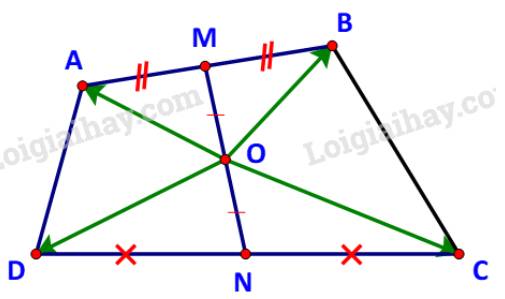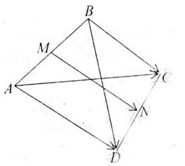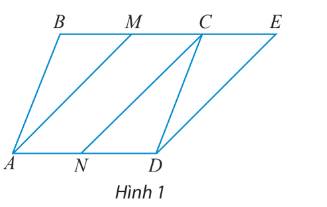Hãy nhập câu hỏi của bạn vào đây, nếu là tài khoản VIP, bạn sẽ được ưu tiên trả lời.

xét tứ giác AECF: có AE = FC và AE//FC => AECF là hình bình hành => AF//CE
xét △DNC: có F là trung điểm của DC và FM//CN (đường tb) => M là trung điểm của DN => vtDM = vtMN (1)
xét △BMA: có E là trung điểm của AB và NE//AM ( đường tb) => N là trung điểm của MB => BM=MN (2)
từ (1) và (2) suy ra : DM=MN=NB => vtDM = vtMN = vtNB ( cùng hướng, cùng độ lớn)

a) Giả sử \(\overrightarrow{OA}+\overrightarrow{OC}=\overrightarrow{OB}+\overrightarrow{OD}\)
\(\Leftrightarrow\overrightarrow{OA}+\overrightarrow{OC}-\overrightarrow{OB}-\overrightarrow{OD}=\overrightarrow{0}\)
\(\Leftrightarrow\overrightarrow{OA}+\overrightarrow{BO}+\overrightarrow{OC}+\overrightarrow{DO}=\overrightarrow{0}\)
\(\Leftrightarrow\left(\overrightarrow{BO}+\overrightarrow{OA}\right)+\left(\overrightarrow{DO}+\overrightarrow{OC}\right)=\overrightarrow{0}\)
\(\Leftrightarrow\overrightarrow{BA}+\overrightarrow{DC}=\overrightarrow{0}\) (đúng do tứ giác ABCD là hình bình hành).
b) \(\overrightarrow{ME}+\overrightarrow{FN}=\overrightarrow{MA}+\overrightarrow{AE}+\overrightarrow{FC}+\overrightarrow{CN}\)
\(=\left(\overrightarrow{MA}+\overrightarrow{CN}\right)+\left(\overrightarrow{AE}+\overrightarrow{FC}\right)\).
Do các tứ giác AMOE, MOFB, OFCN, EOND cũng là các hình bình hành.
Vì vậy \(\overrightarrow{CN}=\overrightarrow{FO}=\overrightarrow{BM};\overrightarrow{FC}=\overrightarrow{ON}=\overrightarrow{ED}\).
Do đó: \(\overrightarrow{ME}+\overrightarrow{FN}=\left(\overrightarrow{MA}+\overrightarrow{CN}\right)+\left(\overrightarrow{AE}+\overrightarrow{FC}\right)\)
\(=\left(\overrightarrow{MA}+\overrightarrow{BM}\right)+\left(\overrightarrow{AE}+\overrightarrow{ED}\right)\)
\(=\overrightarrow{BA}+\overrightarrow{AD}=\overrightarrow{BD}\) (Đpcm).


a) \(\overrightarrow {AC} + \overrightarrow {BD} = \overrightarrow {AM} + \overrightarrow {MN} + \overrightarrow {NC} + \overrightarrow {BM} + \overrightarrow {MN} + \overrightarrow {ND} \\= \left( {\overrightarrow {AM} + \overrightarrow {BM} } \right) + \left( {\overrightarrow {MN} + \overrightarrow {MN} } \right) + \left( {\overrightarrow {NC} + \overrightarrow {ND} } \right) \\= \overrightarrow 0 + 2\overrightarrow {MN} + \overrightarrow 0 = 2\overrightarrow {MN} \) (đpcm)
b) \(\overrightarrow {AC} + \overrightarrow {BD} = \overrightarrow {BC} + \overrightarrow {AD} \)
\(\)\(\overrightarrow {BC} + \overrightarrow {AD} = \overrightarrow {BM} + \overrightarrow {MN} + \overrightarrow {NC} + \overrightarrow {AM} + \overrightarrow {MN} + \overrightarrow {ND} \)
\(\left( {\overrightarrow {BM} + \overrightarrow {AM} } \right) + \left( {\overrightarrow {MN} + \overrightarrow {MN} } \right) + \left( {\overrightarrow {NC} + \overrightarrow {ND} } \right) = 2\overrightarrow {MN} \)
Mặt khác ta có: \(\overrightarrow {AC} + \overrightarrow {BD} = 2\overrightarrow {MN} \)
Suy ra \(\overrightarrow {AC} + \overrightarrow {BD} = \overrightarrow {BC} + \overrightarrow {AD} \)
Cách 2:
\(\begin{array}{l}
\overrightarrow {AC} + \overrightarrow {BD} = \overrightarrow {BC} + \overrightarrow {AD} \\
\Leftrightarrow \overrightarrow {AC} - \overrightarrow {AD} = \overrightarrow {BC} - \overrightarrow {BD} \\
\Leftrightarrow \overrightarrow {DC} = \overrightarrow {DC} (đpcm)
\end{array}\)

Áp dụng tính chất trung điểm ta có:
Do J là trung điểm của BD nên \(2\overrightarrow{IJ}=\overrightarrow{IB}+\overrightarrow{ID}\).
Theo quy tắc ba điểm: \(\overrightarrow{IB}=\overrightarrow{IA}+\overrightarrow{AB}\)
\(\overrightarrow{ID}=\overrightarrow{IC}+\overrightarrow{CD}\).
Vì vậy: \(2\overrightarrow{IJ}=\overrightarrow{IB}+\overrightarrow{ID}=\overrightarrow{IA}+\overrightarrow{AB}+\overrightarrow{IC}+\overrightarrow{CD}\)
\(=\left(\overrightarrow{IA}+\overrightarrow{IC}\right)+\left(\overrightarrow{AB}+\overrightarrow{CD}\right)\)
\(=\overrightarrow{AB}+\overrightarrow{CD}\) (ĐPCM).

Tham khảo:

Dễ thấy: \(\overrightarrow {OA} = \overrightarrow {OM} + \overrightarrow {MA} \); \(\overrightarrow {OB} = \overrightarrow {OM} + \overrightarrow {MB} \)
Tương tự: \(\overrightarrow {OC} = \overrightarrow {ON} + \overrightarrow {NC} \); \(\overrightarrow {OD} = \overrightarrow {ON} + \overrightarrow {ND} \)
\(\begin{array}{l} \Rightarrow \overrightarrow {OA} + \overrightarrow {OB} + \overrightarrow {OC} + \overrightarrow {OD} = \left( {\overrightarrow {OM} + \overrightarrow {MA} } \right) + \left( {\overrightarrow {OM} + \overrightarrow {MB} } \right) + \left( {\overrightarrow {ON} + \overrightarrow {NC} } \right) + \left( {\overrightarrow {ON} + \overrightarrow {ND} } \right)\\ = \left( {\overrightarrow {OM} + \overrightarrow {OM} + \overrightarrow {MA} + \overrightarrow {MB} } \right) + \left( {\overrightarrow {ON} + \overrightarrow {ON} + \overrightarrow {NC} + \overrightarrow {ND} } \right)\\ = \overrightarrow {OM} + \overrightarrow {OM} + \overrightarrow {ON} + \overrightarrow {ON} \\ = \left( {\overrightarrow {OM} + \overrightarrow {ON} } \right) + \left( {\overrightarrow {OM} + \overrightarrow {ON} } \right)\\ = \overrightarrow 0 + \overrightarrow 0 \\ = \overrightarrow 0 .\end{array}\)

a) Ta có: \(\overrightarrow {EA} + \overrightarrow {EB} + \overrightarrow {EC} + \overrightarrow {ED} \)\( = 4\overrightarrow {EG} + \overrightarrow {GA} + \overrightarrow {GB} + \overrightarrow {GC} + \overrightarrow {GD} \)
Mà: \(\overrightarrow {GA} + \overrightarrow {GB} = 2\overrightarrow {GM} ;\) (do M là trung điểm của AB)
\(\overrightarrow {GC} + \overrightarrow {GD} = 2\overrightarrow {GN} \) (do N là trung điểm của CD)
\( \Rightarrow \overrightarrow {EA} + \overrightarrow {EB} + \overrightarrow {EC} + \overrightarrow {ED} = 4\overrightarrow {EG} + 2(\overrightarrow {GM} + \overrightarrow {GN} ) = 4\overrightarrow {EG} \) (do G là trung điểm của MN)
b) Vì E là trọng tâm tam giác BCD nên \(\overrightarrow {EB} + \overrightarrow {EC} + \overrightarrow {ED} = \overrightarrow 0 \)
Từ ý a ta suy ra \(\overrightarrow {EA} = 4\overrightarrow {EG} \)
c) Ta có: \(\overrightarrow {EA} = 4\overrightarrow {EG} \Leftrightarrow \overrightarrow {EA} = 4.(\overrightarrow {EA} + \overrightarrow {AG} ) \Leftrightarrow - 3\overrightarrow {EA} = 4\overrightarrow {AG} \)
\( \Leftrightarrow 3\overrightarrow {AE} = 4\overrightarrow {AG} \) hay \(\overrightarrow {AG} = \frac{3}{4}\overrightarrow {AE} \)
Suy ra A, G, E thẳng hàng và \(AG = \frac{3}{4}AE \) nên G thuộc đoạn AE.


N là trung điểm của CD:
2 =
= +
+  (1)
(1)
Theo quy tắc 3 điểm, ta có:
 =
=  +
+ (2)
(2)
 =
=  +
+  (3)
(3)
Từ (1), (2), (3) ta có: 2 =
=  +
+ +
+ +
+
vì M là trung điểm của Ab nên:  +
+ =
= 
Suy ra : 2 =
= +
+
Chứng minh tương tự, ta có 2 =
=  +
+
Chú ý: Sau khi chứng minh 2 C =  +
+ ta chỉ cần chứng minh thêm
ta chỉ cần chứng minh thêm  +
+ =
=  +
+ cũng được
cũng được
Ta có:  +
+ =
=  +
+ +
+ +
+
=  +
+ +
+ +
+ =
=  +
+ +
+
Vì  =
=  nên ta có:
nên ta có:  +
+ =
= +
+
và 2 =
=  +
+ =
=  +
+

a) Ta có: \(\overrightarrow {CE} = \overrightarrow {AN} \Rightarrow CE//AN\) và \(CE = AN = ND = BM = MC\)
Suy ra \(\overrightarrow {MC} = \overrightarrow {CE} \)
+) \(\overrightarrow {NC} + \overrightarrow {MC} = \overrightarrow {NC} + \overrightarrow {CE} = \overrightarrow {NE} \)
+) ABCD là hình bình hành nên \(\overrightarrow {CD} = \overrightarrow {BA} \)
\(\overrightarrow {AM} + \overrightarrow {CD} = \overrightarrow {AM} + \overrightarrow {BA} = \overrightarrow {BM} \)
+) Ta có \(\overrightarrow {MC} = \overrightarrow {AN} \Rightarrow AMCN\) là hình bình hành nên \(\overrightarrow {NC} = \overrightarrow {AM} \)
\(\overrightarrow {AD} + \overrightarrow {NC} = \overrightarrow {AD} + \overrightarrow {AM} = \overrightarrow {AE} \) (vì AMED là hình bình hành)
b) Ta có:
+) \(\overrightarrow {NC} - \overrightarrow {MC} = \overrightarrow {NC} + \overrightarrow {CM} = \overrightarrow {NM} \)
+) \(\overrightarrow {AC} - \overrightarrow {BC} = \overrightarrow {AC} + \overrightarrow {CB} = \overrightarrow {AB} \)
+) \(\overrightarrow {AB} - \overrightarrow {ME} = \overrightarrow {AB} - \overrightarrow {AD} = \overrightarrow {AB} + \overrightarrow {DA} = \overrightarrow {DB} \)
c) Ta có:
\(\overrightarrow {AM} + \overrightarrow {AN} = \overrightarrow {AM} + \overrightarrow {MC} = \overrightarrow {AC} \)
Áp dụng quy tắc hình bình hành vào hình bình hành ABCD ta có
\(\overrightarrow {AB} + \overrightarrow {AD} = \overrightarrow {AC} \)
Từ đó suy ra \(\overrightarrow {AM} + \overrightarrow {AN} = \overrightarrow {AB} + \overrightarrow {AD} \) (đpcm)



AECD là hình bình hành \(\Rightarrow\) EN//AM
E là trung điểm của AB \(\Rightarrow\) N là trung điểm của BM , do dó MN = NB
tương tự , M là trung điểm của DN , do đó DM = MN.
vậy \(\overrightarrow{DM}=\overrightarrow{MN}=\overrightarrow{NB}\) (đpcm)